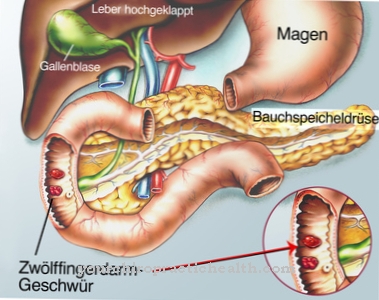The so-called Quadriceps femoris muscle is located on the abdomen (front or ventral side) of the thigh and consists of four different muscle heads. That is why it is colloquially referred to as the four-headed thigh extensor, the four-headed thigh muscle or the quadriceps.
What is the quadriceps femoris muscle?
At the Quadriceps femoris muscle it is the anterior skeletal muscle of the thigh. Since it consists of four different parts (called muscle heads), it is often called the somewhat colloquial four-headed thigh muscle, four-headed thigh extensor or quadriceps.
On average, it is more than 150 cm² wide and is therefore one of the strongest muscles in the human body. Due to its width, it significantly shapes the lateral contours and the front of the thigh and gives them their shape. If the function of the quadriceps is influenced, this can have a significant effect on the entire movement function when running and standing.
Anatomy & structure
The quadriceps are made up of four different parts, which are called muscle heads in medical terminology. These four individual muscle parts are called the straight thigh muscle (also Rectus femoris muscle called) than the centrally located broad muscle (Vastus medialis muscle) than the middle broad muscle (also Vastus intermedius muscle called) and as the outer broad muscle (Vastus lateralis muscle) titled. Each individual muscle head has its own tasks and functions that ultimately influence the overall function of the quadriceps femoris muscle. The rectus femoris muscle arises both on the anterior protruding bone of the pelvis (Anterior inferior iliac spine) as well as on the upper edge of the pelvic socket (medical Acetabulum called). The fibers end in the common attachment tendon, the quadriceps tendon. The vastus medialis muscle divides into two parts. One part runs in a spiral shape from the long lying bone ridge of the thigh (Linea aspera) over the anterior bone side (Linea intertrochanterica) of the femoral bone and around the bone shaft until it finally merges into the quadriceps tendon. The second part bypasses the kneecap in the direction of the body and uses the tether of the kneecap (Medial patellar retinaculum) on the medial articular process (Medial condyle) of the tibia (Tibia) on. The vastus lateralis muscle arises from the Linea aspera, winds around the bone shaft of the femur and largely merges into the quadriceps tendon. The vastus intermedius muscle, on the other hand, begins at the front of the femur and ends in the attachment tendon.
Function & tasks
The quadriceps is also known as the four-headed thigh extensor because it is the only extensor muscle in the knee joint. For this reason, it plays a crucial role in almost all movements in which the legs are needed. An extension of the knee is necessary when walking or when getting up from a sitting or lying position, but also when climbing stairs. In addition, the quadriceps femoris muscle prevents the knee joint from buckling when standing and walking.
It also strengthens and supports the hip joint and has a significant effect on the rotation of the knee joint. This means that it also influences movements that take place in the lower part of the legs. If the quadriceps are injured or impaired, severe disorders of the movement sequence occur. In a small form, these can make walking or standing difficult. In the event of a severe failure of the quadriceps femoris muscle, it can also happen that the leg buckles completely at the knee joint and the person concerned is unable to successfully load it. In other cases, the quadriceps femoris muscle contracts in an uncontrolled manner, which also leads to disturbed movements.
In addition to the functions necessary for movement, the quadriceps femoris muscle also has protective functions: If the knee is stretched, the quadriceps, by targeting the correct muscle parts, prevents surrounding tendons, nerves and tissue from becoming trapped between the kneecap and the thigh bone.
Illnesses & ailments
The four-headed thigh muscle can be disturbed in its function both by external influences and by diseases of the body (such as the intervertebral discs). Typical injuries to the quadriceps are strains of the individual muscle heads, which can occur, for example, due to excessive strain during sports or accidents. This usually manifests itself in pain that restricts mobility. Depending on the severity and type of injury, the symptoms and restrictions can last for several days to weeks.
The function of the quadriceps is also impaired by herniated discs or by strokes in which the L3 and L4 nerve roots or the patellar tendon reflex (PSR) have been impaired or canceled. In this case, there is less pain than numbness and paralysis. As a result, the quadriceps relaxes or only contracts in an uncontrolled manner, so that the execution of the movement sequences controlled by it is no longer possible or only with great difficulty.
The rectus femoris muscle is one of the shortest muscles in the body. Because of this, of all human muscles, it is the most prone to injury - which ultimately affects the entire quadriceps thigh muscle. Because if the rectus femoris muscle shortens over time, this also affects the entire length of the quadriceps. A progressive shortening of the quadriceps femoris muscle can be counteracted by regular stretching exercises in which the foot is slowly and carefully pulled over and over to the buttocks.













.jpg)

.jpg)
.jpg)











.jpg)